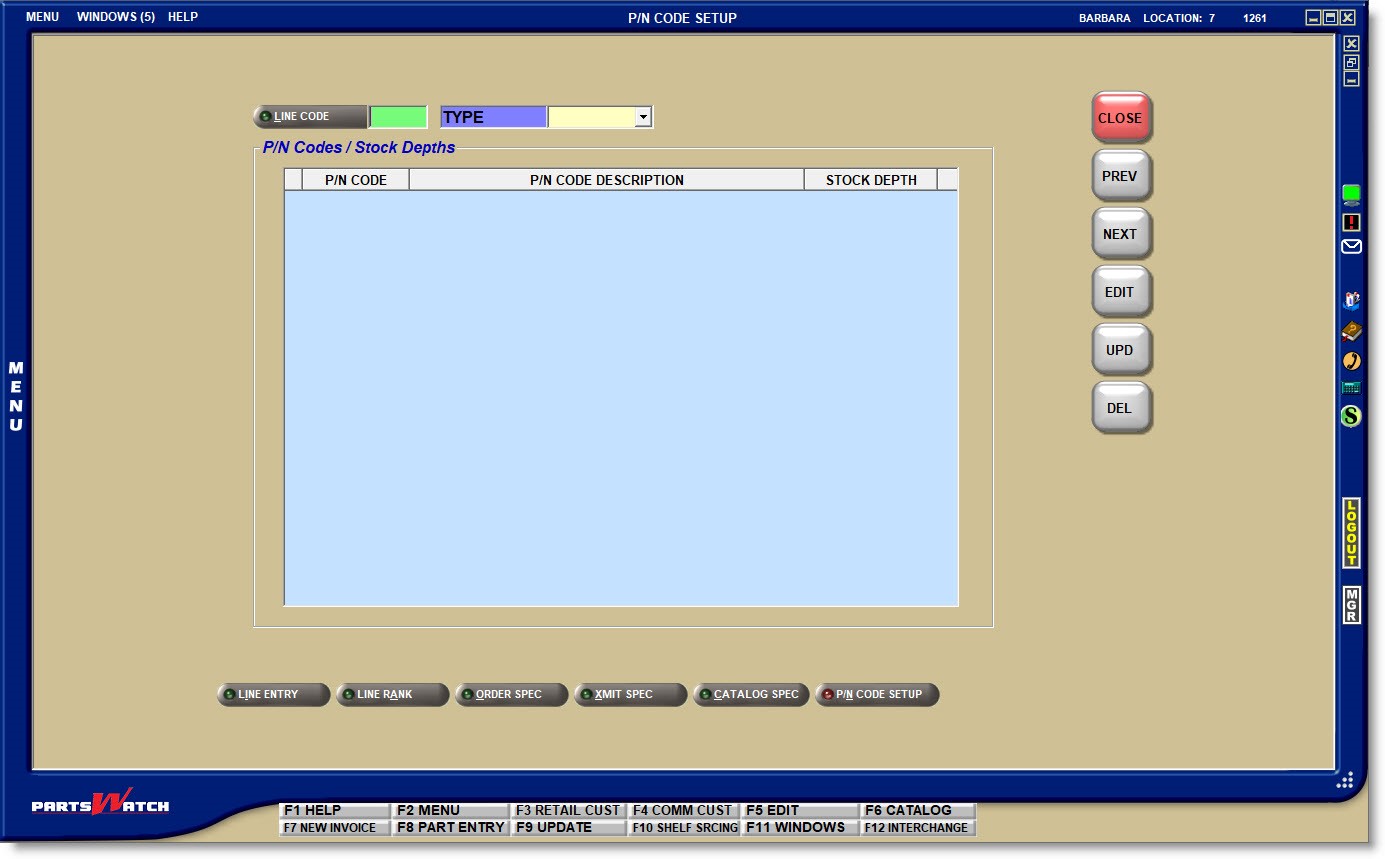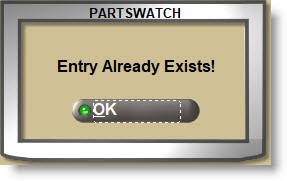Part Price Entry
The PART PRICE ENTRY screen is used to change prices per part number by cost or by price.
Menu Path: Inventory, Part Entry, Part Pricing, PART PRICE ENTRY screen
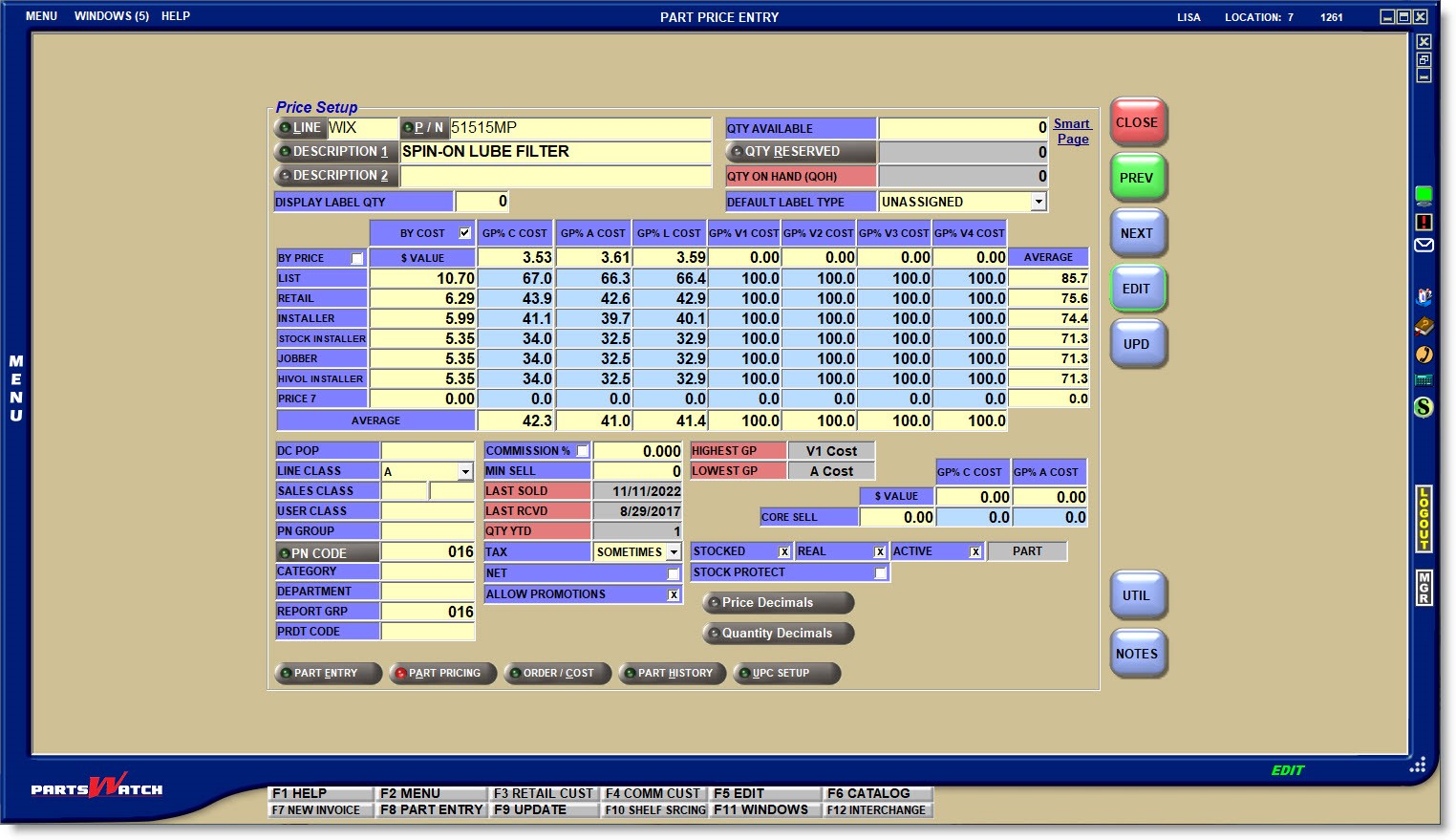
Like most PartsWatch maintenance screens, the 'EDIT' and 'UPD' (update) buttons must be used when changes are made. 'EDIT' must be "off" when entering a part number and "on" when changing the part settings. 'UPD' must be clicked to save the changes.
Therefore, to edit parts using the ‘F’ hot keys:
- (EDIT off) Enter a part number and press 'F5' (EDIT on)
- Make changes and press 'F9' (changes saved)
- Press 'F5' (EDIT off) and find another part
- Press 'F5' (EDIT on) and make changes
- Press 'F9' (changes saved)
If changes are not saved, pressing the 'F5' key, clicking the 'EDIT' button, or closing the screen, a prompt opens to save the changes.

Enter 1-3 alphanumeric characters that represent a valid Line Code in PartsWatch.
- If the value entered is not a valid Line Code, pressing the 'Enter' key moves the cursor to the 'P/N', however, without a part number, the system opens a pop-up stating that the line code is not found.
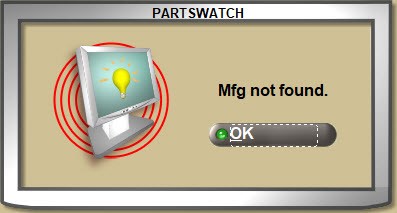
- Click the 'LINE' button to open the 'BROWSE LINE CODES' pop-up to search for a Line Code. Type-ahead can be used to find a Line Code by 'LINE' code, line 'NAME', or 'DESCRIPTION'.
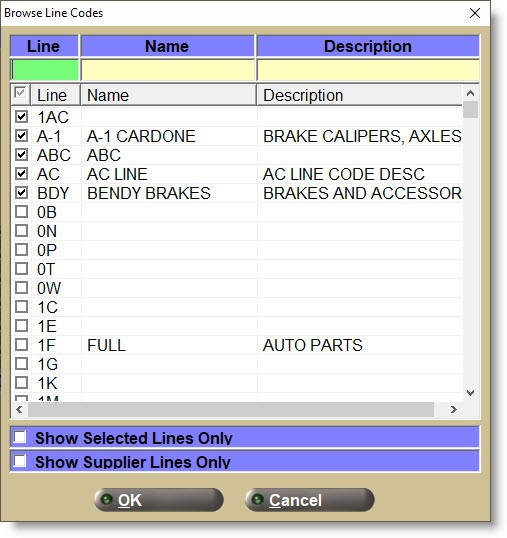
With a 'LINE' displayed:
- Press the 'Enter' key at the 'P/N' field and the first part number from the part table in the Line Code 'SORT CODE' order displays with the part field attributes.
- Enter a valid Part Number in the 'P/N' field and press the 'Enter' key to display the part field attributes for that part.
- The system checks for "stripped" part numbers where letters (A through Z) and numbers (0 through 9) are valid and all other characters are ignored for a part number search.
- If the part number is not found, the system prompts to add it.
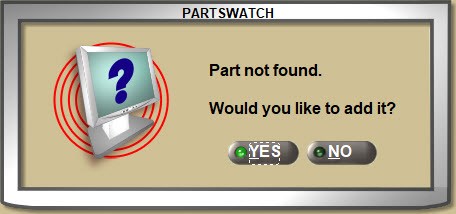
Answer 'Yes' and the part is added.
Answer 'No' and the 'P/N' field clears.
Without a 'LINE' displayed:
- Enter a Part Number and if a single match is found, it will display.
- If more than a single match is found, the Available Matches window opens with all Line Codes that contain the entered part number. Select the correct one to display that Line and Part Number.
- If a match is not found, the cursor remains in the 'P/N' field waiting for valid input.
Click the 'P/N' button to open the 'FIND PART' window to search for a Part Number with or without a Line Code entered in the 'LINE' field.
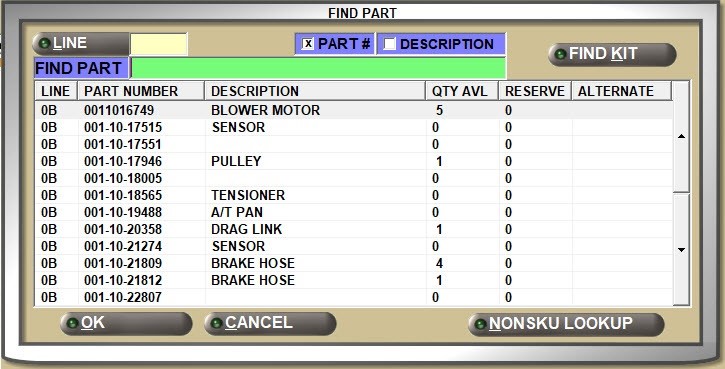
Enter up to 255 alphanumeric and special characters that describe the part in focus.
Click the 'DESCRIPTION 1' button to open the 'FIND PART' window to search for parts by description. Focus is on the 'FIND DESC' field in the pop-up.
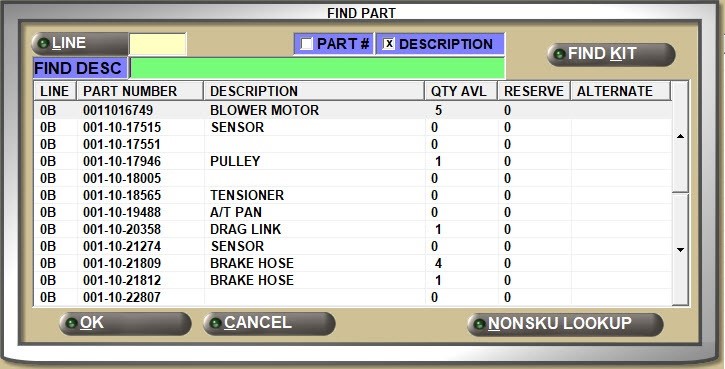
Enter up to 255 alphanumeric and special characters that describe the part in focus with an additional description that, depending on the process, can be used with or instead of 'DESCRIPTION 1'.
The 'DESCRIPTION 2' button is not enabled for a search, and instead, click the 'DESCRIPTION 1' button to locate a part from the 'FIND PART' window by description.
Stock Quantities
Displays the number of units that are on the shelf and available for sales for the part. The field is updated by Point-of-Sale and Purchasing, as well as manually editable.
Displays the number of units that are "on reserve" on open sales orders for the part, for information only.
If the quantity is on reserve, click the 'QTY RESERVED' button to open the 'ON RESERVE' window with the accounts and sales order reference numbers that the part in focus is on.
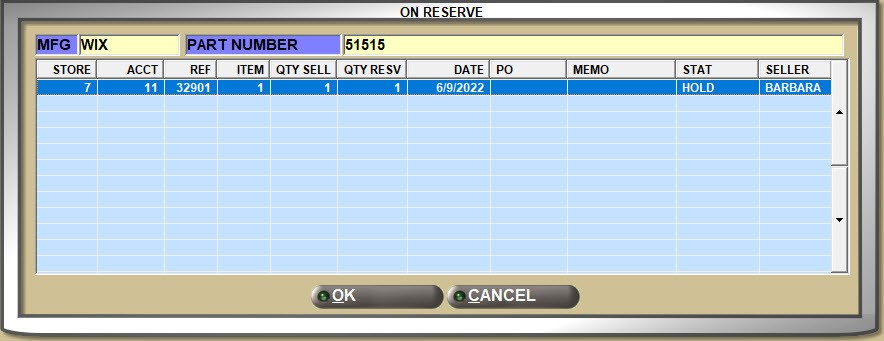
Displays the total number of parts currently in stock whether on the shelf or on an open sales order. ('QTY AVAILABLE' + 'QTY RESERVED')
Click the 'Smart Page' link to open a browser with the manufacturer part information.
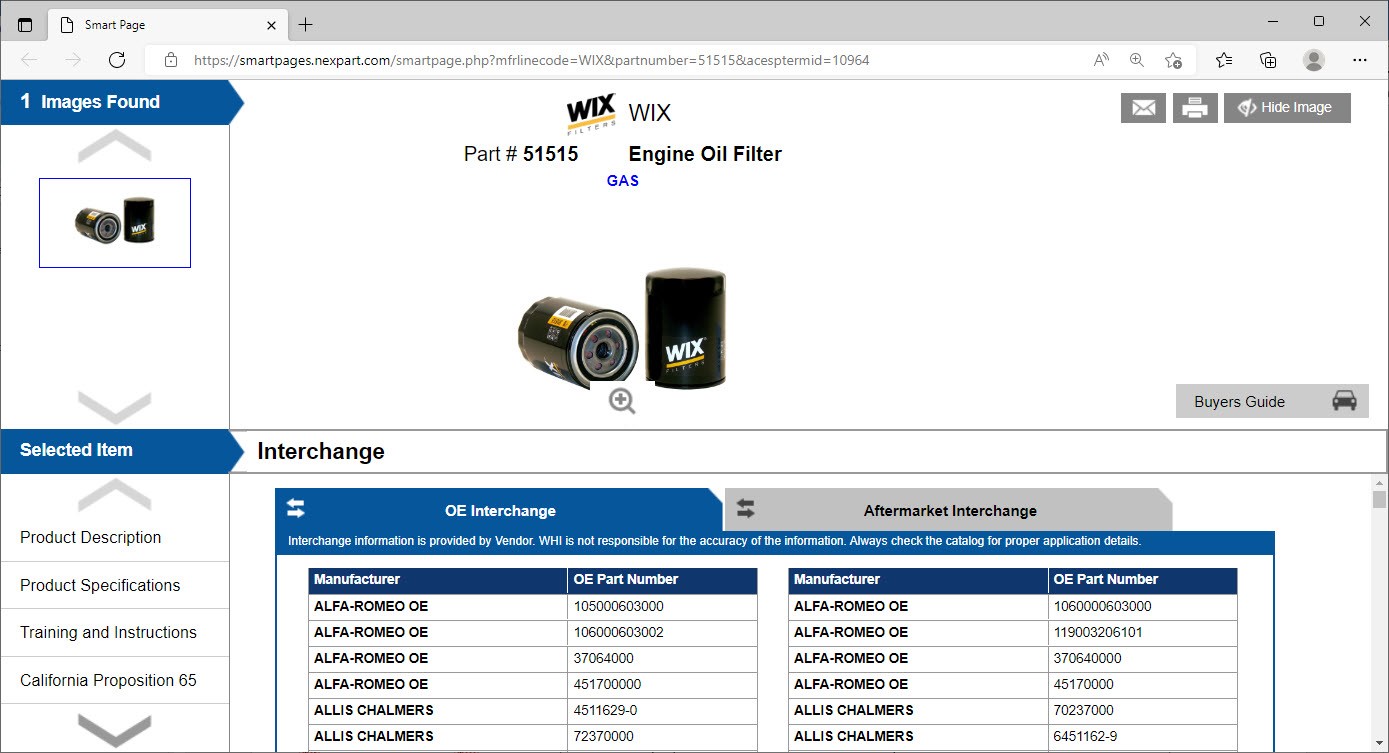
If a link is not found, a pop-up opens stating the page is not found.
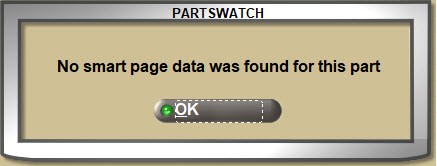
Additionally, if using the Epicor catalog, and Cover to Cover information is available for the entered 'LINE' and 'P/N', the Cover to Cover link displays instead of Smart Page.

Price Labels
Shelf price labels are printed from the PRINT LABELS screen using default setups per part.
Enter the default number of shelf price labels that will print for this part. The default can be changed at the time the labels are printed.
A value greater than '0' must be selected in order to use this default when printing labels.
Shelf price labels are normally printed when a price change has occurred.
Select the default label format that will print for the part.
- UNASSIGNED
- 0 - 2.0 x 1.125 IN (roll)
- 6 – 1.5 X .75 IN (roll)
- 8 – 2.25 x 1.25 IN (roll)
- 9 – 1.0 x 2.125 IN (roll)
- 7 – 1.25 X 2.5 IN (sheet – 24)
- 1 – 4 x 2 IN (sheet - 10)
- 2 – 3 x 5 CM (sheet – 32)
- 4 – 7 x 2.35 CM (sheet – 32)
- 5 – 6.35 x 9.75 CM (sheet)
Note: An application switch determines if the field displays and can be edited or if the field is grayed out and cannot be edited.
The default can be changed at the time the labels are printed.
Price Change Matrix
The pricing matrix in the center of the screen is used to fine-tune profit on the inventory value primarily when a price or cost change occurs, to make sure the Gross Profit Percent (GP%) is not impacted.
Either customer pricing or company cost can be recalculated based on the Gross Profit Percent (GP%) desired on a sale, or recalculates the GP% by changes to either customer pricing or company cost.

Understanding the matrix:
- 'PRICE 1' through 'PRICE 7' sell price levels (as named in the FIELD NAME SETUP screen) display in the first column (under 'BY PRICE').
If the 'AUDIT PART COST EDITS' setting is enabled, edits to the price levels are tracked and can be reported from the 'PART LEDGER COST EDITS REPORT'. - The (yellow) column under '$ VALUE' displays the dollar amount of each sell price level.
- The amount in the (yellow) fields to the right of '$ VALUE' display the dollar amount of each cost level under the column header: 'GP% C COST' (current cost), 'GP% A COST' (average cost), 'GP% L COST' (last cost), 'GP% V1 COST' (vendor cost 1), 'GP% V2 COST' (vendor cost 2), 'GP% V3 COST' (vendor cost 3), 'GP% V4 COST' (vendor cost 4).
- The blue fields in the center represent the GP%.
- In this example, 'LIST' is '15.00', 'RETAIL' is '13.85', 'GP% C COST' (current cost) is '9.00', and the GP% for 'RETAIL' is '35.0'.

- The 'AVERAGE' GP% is calculated for each sell price level by adding the GP% across the row and dividing by 7.
- The 'AVERAGE' GP% is calculated for each cost level by adding the GP% down the column and dividing by the number of values greater than 0.
- The 'HIGHEST GP' field displays the price or cost level that currently has the highest GP% for information only.
- The 'LOWEST GP' field displays the price or cost level that currently has the lowest GP% for information only.
Using the Matrix:
- When a price change occurs, in order to make sure the GP% is maintained:
- With either 'BY PRICE' or 'BY COST' checked, enter the new sell price or cost and press the 'Enter' key. The GP% is recalculated.
- Check 'BY PRICE', change the GP% and press the 'Enter' key. The sell price level is recalculated.
- Check 'BY COST', change the GP% and press the 'Enter' key. The cost level is recalculated.
- Click the 'UPD' button ('F9' key) to save the changes to the part table.
Core Change
The core change fields below the price change matrix are used for core parts when a price change occurs that impacts core.

- Edit the 'CORE SELL', 'GP% C COST' (core cost), or 'GP% A COST' (core average cost) and press the 'Enter' key to recalculate the GP%.
- With the 'BY PRICE' field checked in the price change matrix, edit the GP%, press the 'Enter' key, and the 'CORE SELL' is recalculated.
- With the 'BY COST' field checked in the price change matrix, edit the GP%, press the 'Enter' key, and the 'GP% C COST' or 'GP% A COST' is recalculated.
Reporting Filters
Part Filters
There are eleven part filters that can be optionally used to "group" parts together in a Line or across Lines for purchasing and reporting.
Unless otherwise stated, all filters are optional and user-defined.
When setting up part filters, first determine how they will be used:
The parts considered for purchasing order creation can be filtered by:
- Order Type
- PN Group
- Department
- PN Code
- Category
- Sales Class
Depending on the report, part filters are available to filter report output. For example, all eleven filters are available for the INVENTORY INFORMATION, INVENTORY COUNT, and INVENTORY COST REPORTS.
- Distribution Center (DC) Popularity (POP) Code.
- Up to 5 alphanumeric and special characters.
- Used for inventory reporting.
- Manufacturer's Line Class Code.
- Only 1 alpha or numeric character.
- Only the LINE CLASS Codes set up per line code are available for selection.
- Sales Popularity Code.
- Used to rank and track the popularity of parts.
- Only 1 alpha or numeric character in each of the two field positions.
- User-defined.
- Only 1 alphanumeric or special character.
- Part Number Group Code.
- Up to 10 alphanumeric, user-defined characters.
- Part Number Code.
- Up to 3 alphanumeric characters.
- Only the P/N CODES set up per line code are available for selection.
- P/N Codes are used as "sublines" to categorize parts into groups. For example, oil filters can be grouped by conventional, light-duty, heavy-duty, racing, etc.
P/N Code Setup
P/N Codes must be set up on the P/N CODE SETUP screen in order to be available to the 'P/N CODE' part filter.
- Divisions that parts might be divided into.
- Can be used in conjunction with 'DEPARTMENT' to identify specific types of parts within the areas. For example, 'NUT' for nuts or 'BLT' for bolts might be categories within the 'HDW' hardware department.
- Up to 3 alphanumeric and special characters.
- Areas or types that parts might be categorized as.
- Can be used in conjunction with 'CATEGORY' to identify specific part types or areas of use. For example, a department might be 'HDW' for hardware.
- Up to 3 alphanumeric and special characters.
- Report Group Code.
- Up to 8 alphanumeric and special characters.
Even though they are used as report filters and can mean different things to the store, this is used primarily to include or exclude parts from inventory report output.
- Product Code.
- Up to 3 alphanumeric and special characters.
Enter the percent used to calculate the commission if it is paid to the salesperson when the part is sold at Point-of-Sale.
Commission Setup Hierarchy
Enter the minimum quantity of the part in focus that must be sold at Point-of-Sale. The system forces the quantity to be sold to the 'MIN SELL' quantity in order to continue with the sale. If a value other than the 'MIN SELL' is entered in the 'SELL' field and the 'Enter' key is pressed, the system prompts to enter the correct sell quantity.
Allows entry of '0' - '65535'
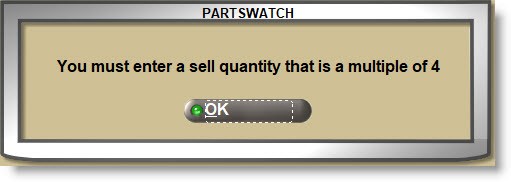
Displays the date that the part was last sold at Point-of-Sale.
Displays the date that the part was last received from a purchase order.
QTY YTD (quantity year-to-date)
Displays the net year-to-date quantity sold and returned.
Click the drop-down and select the sales taxability that determines when the system calculates tax on a part sale:
- 'ALWAYS' (parts are always taxed)
- 'SOMETIMES' (depends on the customer sales taxability)
- 'EXEMPT' (never taxed)
Sales Taxability Flow Chart
Determines whether or not the part in focus is eligible for an overall discount at the time of invoicing.
- Checked: If an overall discount is applied to the invoice, the part will not be included in the invoice subtotal used when the overall discount is calculated. Generally, parts that have been given large discounts already should not be included in the overall discount calculation in order to prevent adversely impacting the 'GP%'.
- Unchecked: The part will be included when an overall discount is applied to the invoice subtotal.
Determines whether or not the part is available for promotional pricing.
- Checked: The part is sold at promotional pricing.
- Unchecked: The part is not sold at promotional pricing. When unchecked, the part is not available for promotional pricing.
"Stocked" parts are inventoried, ordered, and kept on the shelf.
"Real" parts are actual, physical parts as opposed to "parts" used for other things, such as coupons.
"Active" parts can be defined however needed. For example. "active" parts might have a min/max and stock quantity while "inactive" parts do not.
Determines whether or not 'MIN', 'MAX', and/or 'ORDER POINT' can be updated when running the 'SET MIN MAX ORDER POINT' utility.
- Checked: The 'UPDATE' button is available and changes will affect the part table attributes if clicked.
- Unchecked: The 'UPDATE' button is not available. The results can be printed or previewed as report-only.
Optionally, any parts that should be priced with fractional quantities, for example $2.273 or $2.275, instead of the normal two decimal places, can be set up by clicking the 'Price Decimals' button to open a window to select either '3' or '4' decimal places per part.
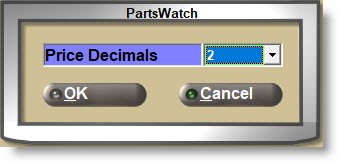
Optionally, to track any parts with fractional quantity units, instead of whole units, click the 'Quantity Decimals' button to open a window to select '1' or '2' decimal places per part. For example, 1.5 feet of hose or 2.25 gallons of oil.
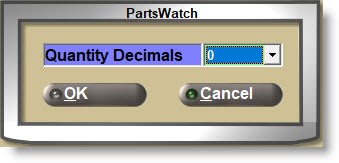
The following Invoicing functions support selling quantities with 0, 1, or 2 decimal places:
- Point-of-Sale selling and returning of regular parts or kit component parts.
- The PW Standard Invoice forms and cash slip receipts.
- Updating part ledger and part histories with fractional units.
- Rebates.
The following Invoicing functions will only support sell quantities using whole units:
- Scanning parts with any wired or wireless scanning device.
- Catalog.
- Quick and Advanced Sourcing.
- Promotions.
- Mode 2.
All Purchasing functions support purchase or return order quantities using whole units. All fractional units for 'QTY AVAILABLE' or 'QOH' are “rounded-up” to calculate whole unit order quantities transmitted in the purchase or return orders to all vendor suppliers.
Most inventory maintenance screens support fractional decimals.
Most inventory reports support fractional decimals.
Whether the 'EDIT' button is enabled or not, click the 'UTIL' button to open a window with a number of features.
Click the 'NOTES' button to display the 'INVENTORY NOTES' window used to set up a part note for Invoicing and/or Purchasing.

